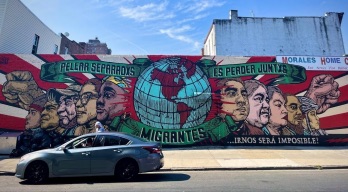South Bronx residents are open to welcoming migrants, but have their own complaints with the city.
“There’s so many people flooding in,” said Loretta Johnson, 34, who works as a public defender in Mott Haven. “We already have a housing crisis.”
More than eight in 10 registered New York voters say that the migrant crisis is a “serious problem,” with more than half saying it is “very serious,” according to an August poll. By a 58-36% margin, New Yorkers said that the state has done enough to take in and assimilate migrants and that they need to “slow the flow.”
Over 110,000 asylum seekers have arrived in New York City since the spring of 2022. Many of them have crossed the southern border from Venezuela, where the economy is collapsing under an authoritarian government. Around 10,000 migrants are arriving in New York City each month, according to the Mayor’s office.
While many South Bronx community members sympathize with migrants, some feel the crisis is compounding existing problems that have gone unaddressed by the city.
“We already have a lot of homeless people here, so how can you fix that problem first?” said Joseph Muldrow, 29, a father and substitute teacher in the Bronx.
With around 60,000 migrants in the city’s care, New York’s shelter system is buckling. Since June, the city has set up over 200 temporary emergency shelter sites to alleviate some of the pressure.
“I do have concerns about the way things are being handled,” said Johnson. She is one of the dozens of concerned parents pushing back against the city’s proposal to temporarily house asylum-seekers in schools.
“I think we need to do everything we can to serve them and help them deal with the trauma, but not at the expense of potentially putting our children’s safety at risk,” she said.
“We’re talking about humans and you’re not going to bring people here just to have them on the streets,” said Grisel Acosta, 34, an elementary school teacher in special education at PS 17 in Mott Haven. Acosta finds it especially heartbreaking to witness migrant children on the street, rather than in the classroom.
Camila Galan, 32, works in a retail store, supporting her three children and herself on $10 an hour. As an immigrant who came from Mexico to the US at the age of 17, she understands first-hand why asylum-seekers come to the United States.
“My country is beautiful but it’s very difficult. You don’t have opportunities that you have here,” she said. Still, without legal documentation, Galan believes that until the government can offer assistance to longtime working immigrants like her, the state should slow the flow of migrants to New York.
“They should help with immigration lawyers such as domestic violence and other types of services since we are many immigrants who work without having documents in this generous country,” she said.
Mayor Eric Adams warned that the city will rack up a $12 billion deficit over three years to house and care for migrants. In order to stabilize the city’s finances, the Mayor’s office requested city agency leaders to develop a plan for an initial 5% cut in city agency budgets, to be followed by two others later in the year, for up to a 15% cut overall.
“Every service in this city is going to be impacted,” Adams said. He again called for the state and federal government’s assistance.
Loretta Johnson, the public defender, asserts that despite the desperation of the crisis, closing the borders to migrants is inhumane.
“We have an obligation to accommodate migrants, given that we’re New York City,” she said. “We have the Statue of Liberty. To me it sounds crazy to suggest that we should reject them.”

